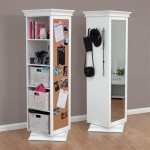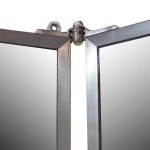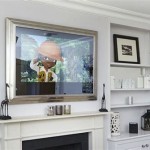Wavy Mirror Tiles: A Comprehensive Guide
Wavy mirror tiles offer a dynamic and visually intriguing alternative to traditional flat mirrors. Their undulating surfaces create captivating light reflections and add a touch of artistic flair to any space. This article explores the various aspects of wavy mirror tiles, from their manufacturing process to their diverse applications and maintenance.
The creation of wavy mirror tiles involves specialized techniques that manipulate the surface of standard mirror glass. One common method utilizes molds during the glass manufacturing process. Molten glass is poured into molds with a wavy texture, imparting the desired shape as it cools and solidifies. Another technique involves carefully bending and shaping cooled glass sheets using controlled heat and pressure. The resulting wavy surface is then coated with a reflective backing, typically silver or aluminum, to create the mirror effect.
Wavy mirror tiles are available in a variety of shapes and sizes, catering to diverse design preferences and project requirements. Rectangular and square tiles remain the most common formats, offered in various dimensions. More specialized shapes, such as hexagons and elongated rectangles, are also available, adding unique design possibilities. Sizes range from small mosaic tiles to larger statement pieces, providing flexibility for different applications.
The amplitude and frequency of the waves in the mirror tiles also contribute to their aesthetic versatility. Low-amplitude waves create a subtle, rippling effect, while high-amplitude waves produce a more dramatic and distorted reflection. Similarly, the frequency of the waves, meaning how close together they are, impacts the overall visual texture. Closely spaced waves result in a busy, textured look, while widely spaced waves produce a more relaxed and flowing appearance.
Beyond their aesthetic appeal, wavy mirror tiles offer several practical advantages. The distorted reflection created by the wavy surface can help diffuse light, reducing glare and softening harsh shadows. This makes them particularly well-suited for spaces with abundant natural light. Additionally, the irregular surface can help to visually camouflage minor imperfections on the wall beneath.
The applications of wavy mirror tiles are diverse, spanning residential, commercial, and artistic installations. In residential settings, they are frequently used in bathrooms, kitchens, and living areas as decorative wall accents or backsplashes. Their light-reflecting properties can enhance the perceived size and brightness of a room, making them a practical choice for smaller spaces. They can also be used to create eye-catching feature walls or to add a touch of glamour to furniture like cabinets or vanities.
In commercial spaces, wavy mirror tiles can be employed to create striking visual displays in retail stores, restaurants, and hotels. Their unique reflective qualities can draw attention to specific areas or products, enhancing the overall ambiance and customer experience. Furthermore, they can be used in reception areas or lobbies to create a memorable first impression.
Artists and designers often incorporate wavy mirror tiles into their work, leveraging their reflective and sculptural qualities. They can be integrated into mosaics, sculptures, and installations to explore themes of light, reflection, and distortion. The interplay of light and shadow on the undulating surfaces can create dynamic and ever-changing visual effects.
Proper installation and maintenance are crucial for preserving the beauty and longevity of wavy mirror tiles. Before installation, ensure the wall surface is clean, smooth, and dry. A high-quality adhesive appropriate for mirror tiles should be used to ensure a secure bond. During installation, care should be taken to align the tiles correctly, maintaining the desired pattern or layout. Spacers may be used to ensure consistent grout lines if applicable.
Cleaning wavy mirror tiles is relatively straightforward. A standard glass cleaner and a soft, lint-free cloth are usually sufficient to remove dirt and smudges. Avoid using abrasive cleaners or scrub brushes, as these can scratch the mirrored surface. For stubborn stains or buildup, a solution of warm water and mild dish soap can be used. Rinse thoroughly with clean water and dry with a soft cloth to prevent water spots.
The versatility of wavy mirror tiles extends beyond their visual appeal. They can be combined with other materials, such as natural stone, wood, or metal, to create unique and personalized designs. They can be incorporated into minimalist settings to add subtle texture or used as a focal point in more eclectic interiors. The interplay of light and reflection offered by wavy mirror tiles makes them a compelling design element in a wide range of applications.

Pack Of 4 Wavy Edged Glass Wall Mount Drilled Mirror Tiles 30 X 30cm

Add A Touch Of Glamour With Wavy Mirror Tiles 6 Self Adhesive Stickers

Buy Chiara 4 Piece Wavy Mirror Tiles Set 30x1x30 Cm In Uae Homebox

Wavy Mirror Wall Stickers 12pcs Full Length 3d Mirrors Art Diy Home Decorative Acrylic Sheet Plastic Tiles For Living Room Bedroom Sofa Tv Setting Decoration Decor

Buy Chiara 4 Piece Wavy Mirror Tiles Set 30x1x30 Cm In Uae Homebox

Buy Chiara 4 Piece Wavy Mirror Tiles Set 30x1x30 Cm In Ksa Homebox

Travelwant 12pcs Wavy Mirror Wall Stickers Full Length 3d Art Diy Home Decorative Acrylic Sheet Plastic Tiles Com

3d Wavy Mirror Wall Sticker Acrylic Tile Temu United Kingdom

3d Wavy Mirror Wall Sticker Acrylic Tile Temu United Kingdom








